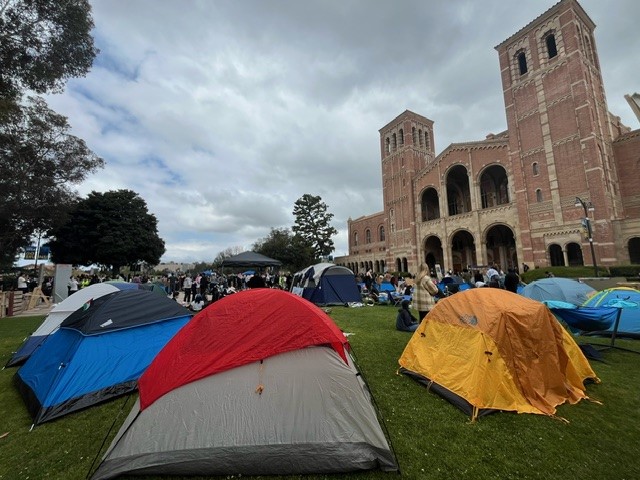Those waiting by the side of the road knew something was about to happen, but not exactly what.
NBC4 and other media had been invited to LAPD's Davis Training Facility in Granada Hills, and we had walked to the Simulation Village.
Down the sidewalk, beyond where we were allowed to go, two men could be seen. Being another unseasonably warm day, the hoodie over one's head seemed out of place.
Then a patrol car rolled up and stopped some 20 feet away. The officers jumped out and from
behind their car doors and yelled at the man hoodie to turn around.
News
Top news of the day
I didn't see it at the time, but it was clear later on recorded video that the man in the hoodie was holding what looked like a gun. Both officers fired, and the man went down.
Then he got up to be replaced by a mannequin.
It was a simulated officer-involved shooting, the prelude of a demonstration for journalists, and a conversation starter with the man standing nearby, LAPD Chief Charlie Beck.
"Every time police officers are forced to use deadly force and somebody dies because of it, that is
a failure to me," Beck said. A frank, but perhaps not unexpected, acknowledgment from a chief who says reducing police use of force is essential to public trust in law enforcement.
For decades in Los Angeles and other cities, uses of deadly force have periodically triggered controversy.
The 2014 shooting of an unarmed man in Ferguson, Missouri raised local police deadly force to a national issue, and gave rise to the Black Lives Matter movement.
In Los Angeles, activists focused attention on the death of Ezell Ford, a South LA resident described by his family as developmentally disabled, during a confrontation with LAPD officers as he walked near his home. The LAPD commission later criticized the tactics of one of the officers.
Last fall, Beck directed LAPD to research and prepare its first comprehensive report on use of force since 2012. Released Tuesday, it found that the 38 officer-involved shootings last year were the
highest annual total since 2011. Of those wounded or killed, the report identified 22 Hispanic, 8 African American, five Caucasian.
To Beck, the emphasis some police critics have placed on race is a distraction from what he sees as the crux issue: preventing situations from developing and reaching the point where officers perceive a lethal threat and fire.
"Many times when they are justified, we can see places where intercepts could have been made to change the end result," Beck said.
In recent years, LAPD has made a series of updated and additions to officer training. Last year, all officers were required to take a five hour "preservation of life" class, which included mechanisms for de-escalating situations.
LAPD has also developed a 40-hour course focused on interacting with individuals with mental illness.
The 2015 Use of Force Report found 14 of the 38 suspects killed or wounded had indications of mental illness, the highest number in the five years examined, and nearly three times the five in 2014.
"We'll have to wait to see if this report results in a transformative shift in the ways officers patrol
the streets," said Pete White, executive director of the Los Angeles Community Action Network.
Wednesday, at the Davis Training Facility, LAPD officials also spoke of the agency's commitment to equipping officers with nonlethal methods of stopping threatening suspects.
"The intent is to incapacitate them," said Michael Hall, officer in charge of firearms training.
Many of the nonlethal options have been available for years, but use of two types increased significantly last year, 31 percent for beanbag rounds, and 24 percent for stun guns.
A gun that shoots 40 mm foam rounds that has been used by SWAT may be made available to patrol officers as well, Hall said. The department is also looking at switching to a non-aerosol pepper spray, so that officers are less likely to be adversely affected when it's deployed.
LAPD's current approach to investigating officer-involved shootings dates to the era of the department's consent decree with the U.S. Department of Justice in the aftermath of the Rampart scandal.
As part of the terms, LAPD established a dedicated section that became known as the Force Investigation Division.
Ten or more detectives respond to each incident, said Lt. Steve Lurie, officer in charge of Force Investigation Division. They are divided into two teams, one handling the administrative investigation, and another focuses on potential criminal prosecution. Investigations usually require half a year, Lurie said.
After Wednesday's simulated shooting, detectives from the division demonstrated how an investigation proceeds, including mapping the scene, having the officers involved do a walk through, and interviewing witnesses.
In this case, the witnesses were the invited journalists. As it turned out, there were significant variations in their accounts of the simulated shooting. Not everybody saw the suspect gun. Nor did everyone hear the officers shout before firing.
"All of those facts are here in the witness statements," Lt. Lurie observed. "But not one witness statement was exactly right."
It's what investigators invariably encounter, he said, and one of the reasons why even in the face of public outcry and demands for explanation, it can take FID months to pin down the details of what happened.



